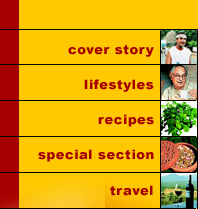
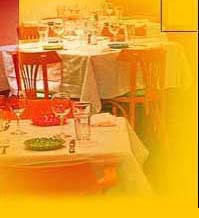

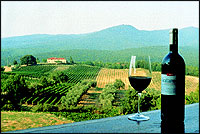 The Bolgheri Story
The Bolgheri Story
Say Tuscany to most people and they think of Chianti. But a true wine lover will think of the Supertuscans. SARA BASRA visited wine estates in the Maremma where the leading light in these parts is the small, upmarket region of Bolgheri, famous for its high quality wines � Sassicaia, Ornellaia, Tignanello. |
|
Let�s start with a game of make believe. Armchair travels. Spin the globe... what appeals? Somewhere sunny and warm, not too hot? Perhaps mountains, and turquoise ocean shimmering below? Okay, shouldn�t be a problem. Sweeping countryside, fine visual arts... Mmmn, stiff demands here. Let�s be real � beautiful people, and great shopping wouldn�t go amiss either. Because no one said dreams can�t be specific.
�Never mind the art, give us some world class football!� comes a plea from the back. Very well, I�m not a fan but I understand the appeal. And, not least, for sure, let�s bring in exciting wines and delicious food. No contest, it has to be Italy. Specifically, Tuscany � in my view, one of the most culturally and viticulturally exciting spots on the planet.
A determined revival is in progress here, triggered by dynamic improvements in the vineyards. The leading light in these parts is the small, upmarket region of Bolgheri, which gained star status from the 1970s onwards for its high quality wines � Sassicaia, Ornellaia, Tignanello � made from so-called French grapes like Cabernet Sauvignon and Merlot.
It was one particularly elegant and enlightened nobleman, the Marquis Mario Incisa, who wrote the opening chapter of the Bolgheri success story. As a student in Pisa during the 1920s, he dreamed of creating a �noble� wine. As in every classic saga, there�s the pivotal part played by marriage, the young Marquis married Clarice, a daughter of the wealthy Della Gherardesca family, who then owned an impressive tract of thousands of hectares of Tuscan coastland.
His Sassicaia wine was not an overnight success. Accustomed to the light, local wines, Italians did not respond to well to the first vintages. So in the early years the wines were drunk only by the Incisa family. But each year, a small number of cases were laid down in the cellars and the Marquis made the exciting discovery that, as the years went by, the wines greatly improved.
As is often the case with wines of great pedigree, those things originally considered defects turned into virtues over time. From the 1970s, Sassicaia streaked to acclaim on the international wine market. Now a blend of Cabernet Sauvignon and Cabernet Franc, it�s considered by many to be Italy�s finest wine and certainly enjoys cult status.
After Sassicaia, came Ornellaia, a vineyard planted by Lodovico Antinori in 1981, with help from Andre Tchelistchev, one of the pioneers of quality Californian Cabernet. At the heart of this vineyard is the Merlot block, named Masseto. It�s a small plot, a mere two hectares in size, but it�s probably the most famous Merlot vineyard in Italy, producing grapes for the powerful, rich Masseto wine.
As Nicolas Belfrage states in his book, From Brunello to Zibobbo. There are rumours of people being prepared to kill for a case of Masseto...�
All eyes are on the Ornellaia estate at present, as it was purchased by Robert Mondavi and his partner, Frescobaldi, in 2002, and a new French consultant winemaker, Thomas Duroux, is at the helm.
Encouraged by the success of Sassicaia and Ornellaia, many others came to Bolgheri to plant vines, and are still coming. But Giancarlo Certini at Antinori�s Guado al Tasso estate is upbeat; �We welcome competition, it creates a more interesting area. It�s just like football, when you have more good teams the championship is much more exciting!�
Certainly the most charismatic newcomer here is Angelo Gaja. Gaja is a wine celebrity of the first order. Renowned for the sheer class of his Barbaresco and Barlolo wines from north Italy, he has done more than anyone to ensure that Italy�s fine wines take their rightful place on the international stage.
A little sceptical of big reputations, I approached the new Gaja winery with some hesitation. So I was somewhat surprised to see the elegant figure of Signor Gaja striding purposefully out to greet me, a warm smile, hugely welcoming, disarmingly courteous, and willing to converse in his perfect, rapid fire English.
The first thing that strikes me about Gaja is his enthusiasm, his passion. The Ca� Marcanda winery, designed by architect Giovanni Bo, was recently completed, and Gaja�s pleasure is evident as he shows me round. His enthusiasm was infectious, and I was impressed; Ca� Marcanda is aesthetically stunning.
This man literally moves mountains. The site was originally flat land, but a hill was created to encapsulate most of the winery. Its vast cellars are entirely underground and deliver the cool, stable environment that the maturing wines require. Everywhere there is art; paintings and sculptures, but also nature�s art.
Outside there are 350 ancient olive trees, with sculptural, twisted branches. The architect used natural materials wherever possible, volcanic basalt paving, intentionally rusted ironwork. No gimmicks, it�s all very sober, very well judged. Very Italian.
Gaja turns round to me with a wide smile, �For lunch, you prefer fish or meat?� Now, contrary to popular belief, it�s quite rare that wine writers get wined and dined. My schedule was so tight that I�d had no time to put petrol in my car let alone grab a bite to eat. But, being characteristically, depressingly, English, I simper politely, �I really don�t mind, either would
be delicious.�
�No! Which one?� Gaja insists.
�Well, fish...� I reply, truthfully.
�I�m so pleased you said fish,� beams Gaja, as we are seated at the La Pineta Restaurant on the beachfront in Bibbona. Owner Luciano Zazzeri brings course after course of the freshest seafood. My nutritional status, and my spirits, soar. Tasting Gaja�s new Bolgheri wines, Magari and the lighter Promis, I would take issue with anyone who feels that France still holds a monopoly on fine wines.
In Italian, Magari means �Here�s hoping.� It�s a wryly humble name, but in fact Gaja is genuinely modest as yet about these wines, as he believes that vines can only delivery outstanding wines after 8 to 12 years. And, with so many young vines in Bolgheri, it�s an exciting thought that the already good wines here can only get better.
As Magari and Promis are both red wines, Gaja had selected the white wine for our meal from a neighbouring Bolgheri producer. Called Costa di Giulia, it�s a blend of Sauvignon Blanc and the native Vermentino grape. And it�s crafted by one of my favourite Bolgheri characters, Michele Satta.
Satta is blessed with a big heart, a particularly large family, and a considerable talent for making interesting wine.
He brings a love, a warmth of spirit to his work that is compelling to witness.
Amidst a sea of Cabernet and Merlot wines, Satta is seen as something of a champion of the native Sangiovese grape here in Bolgheri. Certainly I do rate his 100 per cent Sangiovese wine, called Cavaliere; it�s well balanced with persistent, lively cherry fruit. But also Satta makes a great blended wine, Piastria, from Merlot, Sangiovese, Cabernet and Syrah.
These wines intrigued me. How is such freshness and elegance achieved? Disarmingly, Satta gives superbly philosophical explanations. �Beauty is not something superficial. It�s not a question of technology in the winery. In fact there�s no need of technology. It�s more important to have variance, angles, expression... My love for this work originated from the love I feel for nature and the soil. Many producers are making a market wine. I am making my personal true living wine.�
Call me eccentric, but I hold the view that fine wine is a lot more than merely a pleasant alcoholic drink. It actually has the power to speak to us, through our senses, of the earth and bedrock of its vineyards, and even the culture and history that surrounds its birthplace. Deluded, perhaps, to read so much into a glass of wine?
Well, in Satta, I�ve found someone who shares this view completely. �Wine expresses the fruit, the soil, the weather of the year, the place � but it is human culture that can distinguish and extract these characteristics. This is the most profound meaning of cultivation.�
Later this week, I have an appointment at the stunning Castello del Terriccio estate, north of Bolgheri, a vast and impressively beautiful property, around 1,700 hectares, and dominated by the magnificent Terriccio castle. Everything is shuttered, deserted. There are few things less welcoming than a closed, immense, silent castle.
So, it�s slightly surprising that this discouraging start evolved into the best adventure of my trip. Just as I�m trying to coax my cellphone into a network, a jeep careers round a turret and veers to a halt at my side. The driver is Terriccio�s charismatic owner, Conte Gian Annibale Rossi di Medelana.
Dr. Rossi is one of the great legendary characters in Italian wine culture. His early passion was riding; a talented cross country event rider, he broke his back in the 1980�s in a catastrophic fall. Nothing if not courageous, over recent years, Rossi has devoted himself with considerable energy to the production of some very fine wines indeed. He personally hunted out his Syrah and Viognier vinestock from small high quality vineyards in the south of France.
The wines, not unlike their maker, show complexity, character and style. Terriccio�s Lupicaia red wine hits the mark with seductively perfumed, ripe, elegant fruit. I am also enthusiastic about the Terriccio white wines, Con Vento and Rondinaia.
In 2002, the Lupicaia wine was not made. As in much of Italy, this vintage was very difficult, with prolonged showers which stopped grape maturation and caused rot. The 2002 wines from this area are never going to be great; generally speaking they are certainly comparatively light, underfruited, and early drinking in style.
As Moreno Petrini of the respected Valgiano Estate near Lucca explains, �The 2002 vintage was the worst in the past 10 years. But, let me say this: probably 10 years ago producers would not even have been able to make a wine in such a vintage. It�s a credit to the progress achieved in the vineyards.�
He�s right � until recently Italy�s vineyards were in a mess. Now the serious producers know what they have to do, and they�re doing it. No wine drinker ever fantasised about rootstocks, planting density, canopy management � but these are the buzzwords at the best, cutting edge vineyards, and attention to these details has brought staggering improvements.
I would counsel that you can confidently purchase Bolgheri wines from the vintages of 1997 through to 2001. But, do keep them, let them mature, before drinking. The region enjoyed a run of great luck in good weather over these years. And, unbowed by the challenges of the 2002 vintage, Rossi remains in good spirits; �The wine has given us a lot, over the good vintages, so we should be ready to pay our toll for it. After all, I�m a sportsman!�
Factfile Getting there Accommodation Best books
|

Home Page
About the mag
Subscribe
Advertise
Contact Us

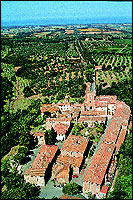 Say Tuscany to most people and they automatically think of Chianti. Gently rolling hills, olive groves, and the ever popular red wine created from the native Sangiovese grape. But it�s likely that a true wine lover will think of the Supertuscans. No, not Latino bodybuilders, but great, powerful, original wines. To track down these wines, I recently spent three weeks visiting wine estates in the Maremma, the slice of west Tuscany coast from Pisa down to Scansano.
Say Tuscany to most people and they automatically think of Chianti. Gently rolling hills, olive groves, and the ever popular red wine created from the native Sangiovese grape. But it�s likely that a true wine lover will think of the Supertuscans. No, not Latino bodybuilders, but great, powerful, original wines. To track down these wines, I recently spent three weeks visiting wine estates in the Maremma, the slice of west Tuscany coast from Pisa down to Scansano.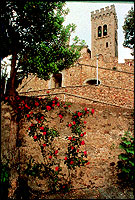 The Maremma is in fact renowned for its fine horses. The creator of Sassicaia, the Marquis Mario Incisa della Rochetta, bred Ribot, who enjoyed the distinction of winning the Prix de l�Arc de Triomphe twice, in 1955 and 1956. An owner with vision, good breeding stock, attention to detail in the training... and, a little luck. Not far different from the needs of a fine wine. And Bolgheri in particular has been dealt a lucky hand, not least in the calibre of producer it has had. Wine is essentially all about people; yes, it is a product of nature, but it is the human touch that releases the magic.
The Maremma is in fact renowned for its fine horses. The creator of Sassicaia, the Marquis Mario Incisa della Rochetta, bred Ribot, who enjoyed the distinction of winning the Prix de l�Arc de Triomphe twice, in 1955 and 1956. An owner with vision, good breeding stock, attention to detail in the training... and, a little luck. Not far different from the needs of a fine wine. And Bolgheri in particular has been dealt a lucky hand, not least in the calibre of producer it has had. Wine is essentially all about people; yes, it is a product of nature, but it is the human touch that releases the magic.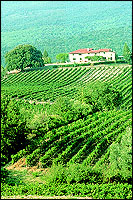 The Marquis settled down with his young wife into their estate at San Guido near the picturesque village of Bolgheri and started planting vines. Eyebrows were immediately raised, for, after all, it was thought that this coastland was only good for cows and horses. Moreover, what he planted created a sensation... Cabernet Sauvignon vines, sourced from Bordeaux in France. These days, Cabernet is ubiquitous worldwide from Sacramento to Shanghai, but in the 1940s it was a very radical move indeed to plant French vines on Italian soil. But, like most of the Italian aristocracy at that time, the Marquis� taste in wine ran strongly to fine Bordeaux. And he had noticed that his soil was gravely and well drained, just as in the renowned Graves region of Bordeaux.
The Marquis settled down with his young wife into their estate at San Guido near the picturesque village of Bolgheri and started planting vines. Eyebrows were immediately raised, for, after all, it was thought that this coastland was only good for cows and horses. Moreover, what he planted created a sensation... Cabernet Sauvignon vines, sourced from Bordeaux in France. These days, Cabernet is ubiquitous worldwide from Sacramento to Shanghai, but in the 1940s it was a very radical move indeed to plant French vines on Italian soil. But, like most of the Italian aristocracy at that time, the Marquis� taste in wine ran strongly to fine Bordeaux. And he had noticed that his soil was gravely and well drained, just as in the renowned Graves region of Bordeaux. The Marquis Mario passed away in 1983, and now it�s his son, the Marquis Nicolo, who holds the reins at Tenuta San Guido. These days Sassicaia shares the applause with a new wine from the estate, Guidalberto, a Merlot/ Cabernet Sauvignon/ Sangiovese blend. As Marquis Nicolo�s nephew, Sebastiano Rosa, explained to me, �We wanted to do something new, something different, after so many years of making one wine. With Merlot and Sangiovese in the mix, it�s a new blend, a new challenge for us.� Guidalberto is lighter, earlier drinking style than its famed stablemate, but both wines do deliver great elegance and finesse in the glass.
The Marquis Mario passed away in 1983, and now it�s his son, the Marquis Nicolo, who holds the reins at Tenuta San Guido. These days Sassicaia shares the applause with a new wine from the estate, Guidalberto, a Merlot/ Cabernet Sauvignon/ Sangiovese blend. As Marquis Nicolo�s nephew, Sebastiano Rosa, explained to me, �We wanted to do something new, something different, after so many years of making one wine. With Merlot and Sangiovese in the mix, it�s a new blend, a new challenge for us.� Guidalberto is lighter, earlier drinking style than its famed stablemate, but both wines do deliver great elegance and finesse in the glass.